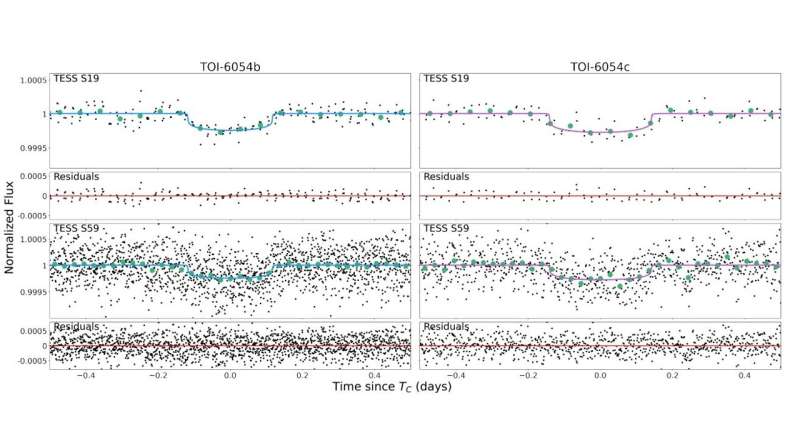
Using NASA’s Transiting Exoplanet Survey Satellite (TESS), an international team of astronomers has discovered two sub-Neptune exoplanets orbiting a subgiant star known as TOI-6054. The newfound alien worlds are nearly three times larger than the Earth. The finding was reported in a paper published Jan. 15 on the pre-print server arXiv.
To date, TESS has identified more than 7,300 candidate exoplanets (TESS Objects of Interest, or TOI), of which 595 have been confirmed so far. Since its launch in April 2018, the satellite has been conducting a survey of about 200,000 of the brightest stars near the sun with the aim of searching for transiting exoplanets—ranging from small, rocky worlds to gaseous giants.
TOI-6054, or TIC 392681545, is an F-type subgiant star located some 259 light years away, about 66% larger but only slightly more massive than the sun. Two transit signals have been identified in the light curve of this star using TESS, and now, a group of astronomers led by Maxwell A. Kroft of the University of Wisconsin–Madison, has confirmed the planetary nature of these signals using the NEID spectrograph on the WIYN 3.5m telescope at Kitt Peak, Arizona.
“We confirm the planetary nature of a pair of transiting sub-Neptune exoplanets orbiting the bright F-type sub-giant star TOI-6054 (V = 8.02, K = 6.673) as a part of the OrCAS radial velocity survey using WIYN/NEID observations,” the scientists write.
The planet closer to the star, designated TOI-6054 b, has a radius of about 2.65 Earth radii and its mass is approximately 12.4 Earth masses, which yields a density at a level of 3.65 g/cm3. TOI-6054 b orbits the host every 7.5 days at a distance of 0.077 AU from it, and its equilibrium temperature is estimated to be 1,360 K.
The second planet, which received designation TOI-6054 c, has a radius of around 2.81 Earth radii, while its mass is 9.2 Earth masses. Therefore, its density was calculated to be approximately 2.27 g/cm3. The planet has an orbital period of 12.56 days and is at a distance of about 0.11 AU from the parent star. The equilibrium temperature of TOI-6054 c is at a level of 1,144 K.
Based on the derived parameters, the authors of the paper classified TOI-6054 b and TOI-6054 c as sub-Neptunes, noting that they are much too large to have a pure rocky composition. They assume that these planets are most likely not hydrogen/helium enveloped rocky worlds or hydrogen/helium-free water-worlds, but they are likely intermediate between these two extremes.
Summing up the results, the researchers underline that the TOI-6054 system should be a great target for follow-up atmospheric characterization observations with the James Webb Space Telescope (JWST). The transmission spectroscopy metric of the two planets suggests that both planets could show detectable atmospheric features in transmission spectroscopy observations.
More information:
Maxwell A. Kroft et al, A Pair of Dynamically Interacting Sub-Neptunes Around TOI-6054, arXiv (2025). DOI: 10.48550/arxiv.2501.09095
Journal information:
arXiv
© 2025 Science X Network
Citation:
Two sub-Neptune exoplanets detected by astronomers (2025, January 23)
retrieved 23 January 2025
from https://phys.org/news/2025-01-neptune-exoplanets-astronomers.html
This document is subject to copyright. Apart from any fair dealing for the purpose of private study or research, no
part may be reproduced without the written permission. The content is provided for information purposes only.

